4.4. Python Implementations¶
Python is generally defined as an interpreted language with on-the-fly compiled p-code [PCODE] for execution speed up. The p-code is executed in a language specific virtual machine - the p-code machine [PCODE] - as the runtime system. The standard reference implementation is CPython based on C, which supports extension modules by it’s C-Extension-API.
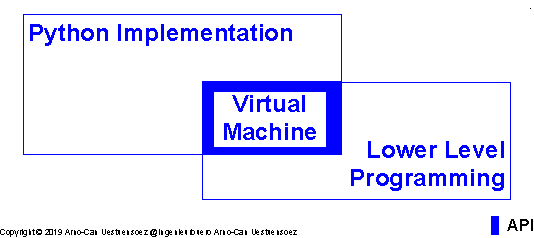
Figure: Structure  ¶
¶
Other implementations exist, which utilize the Java-VM / JVM including just-in-time JIT compilation, more traditional similarity by IronPython implemented in C# based on the .NET-Framework.
The interface for extensions could be applies by various APIs and wrappers. While the native API requires some more in-depth use of the C-Types defined by Python.h, the others provide for more or less additional abstraction of the API. The ctypes standard package provides a Python interface for calling shared library and DLL interfaces by supporting elementary bindings for the exchanged parameters and data. The packages CFFI [CFFI] and Cppyy [CPPYY] provide specific bindings for Python, while the extention Frameworks like SWIG provide a call wrapper for extensions written in different languages including C/C++. The Cython implementation is here somewhat different, as it provides a native Python compiler which preprocesses the Python code into C code with optional Cython and C specific language extensions of the Python syntax.
The relevance for the package pythonids is here the difference in the runtime view of the subsystems from their current execution context. While the modules of pythonids are executed by standard as an imported interpreted native Python module, the extensions are executed within their target language execution context. This has a defining impact on the implicit and/or explicit inspection support of the runtime code and though the evaluation of the distribution parameters.
4.4.1. CPython¶
The CPython implementation is as one of the native standard target of the package platformids. Therefore the runtime environment is identical in both code segments - the caller and the callee platformids. Thus the platformids evaluates it’s own runtime Python distribution correctly as the distribution executing the caller function.
The CPYthon runtime environment based on the Python-Virtual-Machine - PVM, which executes portable intermediate code, the p-code [PCODE].
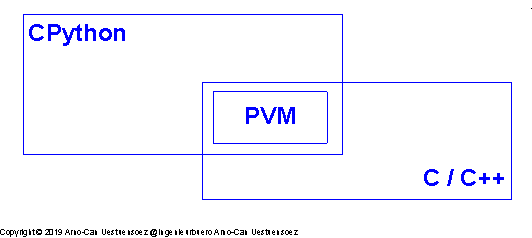
Figure: Structure  ¶
¶
The characterization data is represented by
attribute
values
remarks
category
python
disttype
python<major0>.<minor0>
the version of the Python syntax
dist
cpython
distrel
<major0>.<minor0>.<build0>
in case of CPython the syntax release
hexrelease
0xb2……
the resulting hex encoding
compiler
<C-Compiler>
the used C compiler, e.g. GCC
compiler_version
<major2>.<minor2>.<build2>
the release version of the C compiler
c_compiler
<C-Compiler>
in case of CPython the same as the compiler
c_compiler_version
<major2>.<minor2>.<build2>
in case of CPython the same as the compiler_version
4.4.1.1. The Execution Model¶
The Python interpreter creates by default p-code [PCODE], which is the on-the-fly compiled source code as abstract assembler code. The compilation occurs only in case of an actual change, and only when the sources are present. The p-code is than executed by a virtual processor, the Python-Virtual-Machine - the PVM.
The CPython implementation is hereby implemented itself by C, and provides an API for the direct inclusion of compiled C and C++ based code libraries, or others compliant to the call interface. The reverse call direction of Python call from a C/C++ module is supported too. See CPython Extension Modules.
The important point for pythonids is here the lack of dynamic Python binding information within the C based extensions for introspection. The module inspect for example has no access to the provided symbols within the libraries, in particular when they are stripped off. Therefore the Python implementation of pyhtonids can just detect that the caller is an extension module, and with some heuristics that it is implemented in C/C++ [ARTICLESTACKOFLOWCEXT], but not the type, neither the version. Even though some solutions are possible, the current version of pythonids provides an inline module, with either access to the extension data, or the hard-coded defition of the identifier and version at compile time.
4.4.1.2. CPython Extension Modules¶
For the compiled extension modules some special handling is required, this is extracted into a specific package coming soon [extensionids].
4.4.1.3. The Data Aquisition¶
The aquisition of the modules implementation identifier data is collected and assembled by the pythonids, which is a module itself. In case the caller is implemented as native Python code, the execution environment is the same. Things are different, when the caller is implemented within an extentsion module implemented e.g. in C/C++, see CPython Extension Modules.
4.4.2. IPython¶
The IPython implementation basically extends the standard CPython implementation with interactive features, standalone and embeddable, with an additional GUI based console. IPython could be simply installed as an add-on [IPython] via PyPI [PyPI]. Thus IPython is basically not an separate implementation, but it changes the interactive behaviour of the standard implementation including related output features. This requires in some cases the separate detection, thus it is included as a separate implementation.
Note
See Wikipedia - [IPython].
IPython (Interactive Python) is a command shell for interactive computing in multiple programming languages, originally developed for the Python programming language, that offers introspection, rich media, shell syntax, tab completion, and history. IPython provides the following features:
Interactive shells (terminal and Qt-based).
A browser-based notebook interface with support for code, text, mathematical expressions, inline plots and other media.
Support for interactive data visualization and use of GUI toolkits.
Flexible, embeddable interpreters to load into one’s own projects.
Tools for parallel computing.
The characterization data is basically the same as for CPython represented by
attribute
values
remarks
category
python
disttype
python<major0>.<minor0>
the version of the Python syntax
dist
cpython
distrel
<major0>.<minor0>.<build0>
in case of CPython the syntax release
hexrelease
0xb2……
the resulting hex encoding
compiler
<C-Compiler>
the used C compiler, e.g. GCC
compiler_version
<major2>.<minor2>.<build2>
the release version of the C compiler
c_compiler
<C-Compiler>
in case of CPython the same as the compiler
c_compiler_version
<major2>.<minor2>.<build2>
in case of CPython the same as the compiler_version
4.4.3. IronPython¶
The IronPython implementation is different from the standard C based interpreter distributions. The IronPython package uses the .NET as the runtime virtual machine and integrates into the supported languages, so C#.
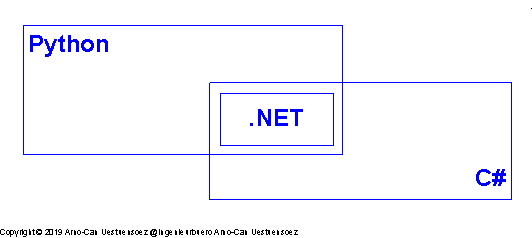
Figure: Structure  ¶
¶
The characterization data is represented by
attribute
values
remarks
category
python
disttype
python<major0>.<minor0>
the version of the Python syntax
dist
ironpython
distrel
<major0>.<minor0>.<build0>
in case of CPython the syntax release
hexrelease
0xb2……
the resulting hex encoding
compiler
.NET
the used C compiler
compiler_version
<major2>.<minor2>.<micro2>.<build2>
the release version .NET compiler
c_compiler
n.a.
c_compiler_version
n.a.
4.4.3.1. The Execution Model¶
will be completed soon
4.4.3.2. The Data Aquisition¶
The access interface to the information about the implementation is the same as for the reference implementation CPython.
4.4.4. Jython¶
The Jython implementation is different from the standard C based interpreter distributions. The Jython package uses the JVM as the runtime virtual machine and integrates into Java.
Note
See Wikipedia - [Jython].
Jython is an implementation of the Python programming language designed to run on the Java platform. It is the successor of JPython.[3]
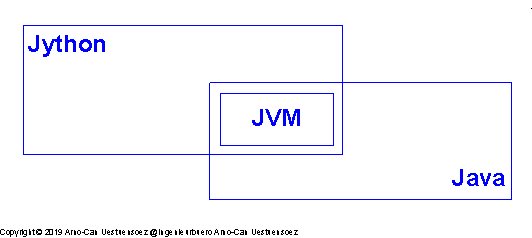
Figure: Structure  ¶
¶
The characterization data is represented by the following table. The special case is here, that the compiler is Java, but the underlying compiler is - intentional - not known.
attribute
values
remarks
category
python
disttype
python<major0>.<minor0>
the version of the Python syntax
dist
jython
distrel
<major1>.<minor1>.<build1>
the release of the Jython implementation
hexrelease
0xb2……
the resulting hex encoding
compiler
java
also relevant for the frequently applied cross-calls between Jyhton and Java
compiler_version
<major0>.<minor0>.<micro0>.<build0>
the special numbering of Java: 1.8.0_181 == 8u181
c_compiler
n.a.
this information is not available
c_compiler_version
n.a.
The significant difference for the user of the pythonids is in case of the Jython distribution the introduction of the type long for unsigned 32bit integers by the Jython compiler. The pythonids uses 32bit values as unsigned integers for bitmaks. Thus e.g. a type comparison of the of the category or hexrelease requires the long type.
# # CPython, etc. # if type(other) is int: proceed_int() # # Jython # else: try: # jython - 32bit is a long(unsigned int) if isinstance(other, long): # @UndefinedVariable proceed_long() except NameError: pass
Just other differences occurs between the various Java releases, which have an impact at least in some specific developement tasks. The Jython implementation relies closely on the actual JVM, thus provides support for the interfaces it could rely on itself. E.g. one difference between OpenJDK for the version 2.7.0 and the Java distribution of Oracle for the version 2.7.1 is the absence of the interface sys.getNativePlatform() for the former. This is the Jython specific interface for the enumeration of the underlying disttype, e.g. as ‘linux2’.
The basic native runtime environment data is handled by Jython commonly in a special way based on the philosophy of platform abstraction of Java. While the implementation data of the runtime information for Java itself is still available, the access to the native data is encapsulated. This is in particular expressed by the attribte os.name, which is set to ‘java’, whereas the attribute ‘os._uname’ is introduced in adddition, which covers the native platform as expected. For further details see [platformids].
4.4.4.1. The Execution Model¶
The Jython distribution uses internally the JVM of the Java runtime environmetns. Therefore the Python code is translated into the p-code of Java and integrated into the complete set of the Java runtime libraries, including the user interface.
Note
See Wikipedia - [Jython].
Jython programs can import and use any Java class. Except for some standard modules, Jython programs use Java classes instead of Python modules. Jython includes almost all of the modules in the standard Python programming language distribution, lacking only some of the modules implemented originally in C. For example, a user interface in Jython could be written with Swing, AWT or SWT. Jython compiles to Java bytecode (intermediate language) either on demand or statically.
Thus the integration supports simplified access to Java based standard and custom packages including applications. The access to other programming languages and the native platform particularly based on C/C++ is still available via the Java Native Interface - JNI, or the derived packages by the community project Java Native Access - JNA. For some further details refer to [platformids].
4.4.4.2. The Data Aquisition¶
The implementation data of the distribution is available by common portable Python interface, while the optional compiler data is here the current Java engine, e.g. based on “java1.7.0_65” or “java1.8.0_181”
The naming and release version numbering scheme is changed by the manufacturer beginning with the preriod of releases of java8 to java12, which in particular includes chnages in licensing. The new categrization based on the license changes provided by the manufacturer inludes the naming jre / jdk and now openjdk by the manufacturer. This includes in particular the update and clearing of the redundant numbering scheme. The old version numbering scheme contained the major version 1 and the micro version 0, which are constants for all previous versions:
java8: jre1.8.0_202 or jre8u202 java9: jre1.9.0_181 or jre9u181
This is changed now e.g. to:
java11: commercial license: jre-11.0.2 + jre-11.0.2 more open license: openjdk-11.0.2 java12: commercial license: jre-12.0.0 + jre-12.0.0 more open license: openjdk-12.0.0
4.4.5. PyPy¶
The PyPy distribution is based on a JIT compiler written in Python itself.
Note
See Wikipedia - [PyPy].
PyPy is an alternative implementation of the Python programming language[2] to CPython, which is the standard implementation of Python. PyPy often runs faster than CPython, because PyPy is a just-in-time compiler, while CPython is an interpreter. Most Python code runs well on PyPy, except for code that depends on CPython extensions, which either does not work or incurs some overhead when run in PyPy. Functionally, PyPy is designed around the technique known as meta-tracing, which transforms an interpreter into a tracing just-in-time compiler. Since interpreters are usually easier to write than compilers, but run slower, this technique can make it easier to produce efficient implementations of programming languages. PyPy’s meta-tracing toolchain is called RPython.
The characterization data is represented by
attribute
values
remarks
category
python
disttype
python<major0>.<minor0>
the version of the Python syntax
dist
pypy
distrel
<major1>.<minor1>.<build1>
the release of the PyPy implementation
hexrelease
0xb2……
the resulting hex encoding
compiler
python
in case of PyPy the CPython
compiler_version
<major0>.<minor0>.<build0>
in case of PyPy the release version of the used CPython
c_compiler
<C-Compiler>
in case of PyP the C compiler used for CPython and by RPython
c_compiler_version
<major2>.<minor2>.<build2>
release of the C compiler
4.4.5.1. The Execution Model¶
The PyPy is written in RPython.
Note
See Wikipedia - [PyPy].
The PyPy interpreter itself is written in a restricted subset of Python, called RPython (Restricted Python).[5] RPython puts some constraints on the Python language such that a variable’s type can be inferred at compile time.[6]
The PyPy project has developed a toolchain that analyzes RPython code and translates it into a form of byte code, together with a interpreter written in the C programming language. Much of this code is then compiled into machine code; and the byte code runs on the compiled interpreter.
It allows for pluggable garbage collectors, as well as optionally enabling Stackless Python features. Finally, it includes a just-in-time (JIT) generator that builds a just-in-time compiler into the interpreter, given a few annotations in the interpreter source code. The generated JIT compiler is a tracing JIT.[7]
RPython is now also used to write non-Python language implementations such as Pixie.[8]
PyPy is compatible with CPython 2.7.13.[9] PyPy3, released starting with version 2.3.1,[10] is compatible with CPython 3.5.3.[9] Both versions have JIT compilation support on 32-bit/64-bit x86 and ARM processors.[11] It is tested nightly on Windows, Linux, OpenBSD and Mac OS X. PyPy is able to run pure Python software that does not rely on implementation-specific features.[12]
See also HPC with Python.
4.4.5.2. PyPy Extension Modules¶
The interface for extensions depends on the applied interface, for an overview refer to HPC with Python. For an investigation and overview of alternatives by Cling refer to [HPCPYPYCLING].
Note
See Wikipedia - [PyPy].
There is a compatibility layer for CPython C API extensions called CPyExt, but it is incomplete and experimental. The preferred way of interfacing with C shared libraries is through the built-in CFFI or ctypes libraries.
For the compiled extension modules some special handling is required, this is extracted into a specific package coming soon [extensionids].
4.4.5.3. The Data Aquisition¶
The data aquisition is compatible to the standard CPython, including the optional compiler parameters with a few deviation of the matched strings.
4.4.6. HPC with Python¶
The implementation of high-performance applications based on Python requires in practical cases the integration of native C/C++ modules, and/or compiled Python code like provided.
Note
See Wikipedia - [PyPy].
There is a compatibility layer for CPython C API extensions called CPyExt, but it is incomplete and experimental. The preferred way of interfacing with C shared libraries is through the built-in CFFI or ctypes libraries.
The compiled extension modules are supported by the package extensionids coming soon [extensionids]. For an investigation and overview of alternatives by Cling refer to [HPCPYPYCLING], for a comparison of “Performance of Python runtimes on a non-numeric scientific code” refer to [PYIMPPERFORM].
4.4.7. Native Python as Virtual OS¶
Some special Python distributions are supported for small embedded systems with limited resources. The distributions MicroPython [MicroPython] and ithe derived CircuitPython [CircuitPython] provide a literally native Python environment, where the interpreter itself is the only and one execution environemnt which is executed as a virtual OS. The interactive command line user interface of the Python interpreter is hereby similar to a common shell [SHELL] replacing the text based dialogue console [SHELLTXT]. Thus these Python implementations of this type represent the complete process execution frame including the lower OS platform as described by platformids, and machineids.

Figure: Integrated Native Shell  ¶
¶
The native Python interpreter includes the required low-level drivers and provides basically a Firmware [FIRMWARE] stack including the compelete high-level execution frame. The targeted devices are small SOC such as the original MicroPython [MicroPython] board
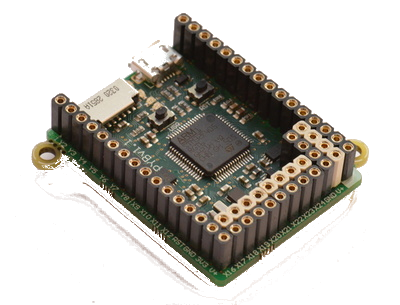
Figure: MicroPython Device  ¶
¶
or the boards supported by CircuitPython [CircuitPython]
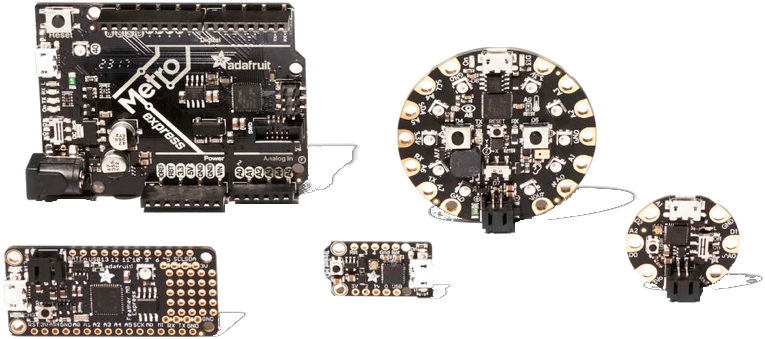
Figure: CircuitPython Device  ¶
¶
For differences between CPython and MicroPython see [MicroVsCPython].
Note
The current version of pythonids does not yet support these implementations.
4.4.7.1. MicroPython¶
The Python variant MicroPython [MicroPython] is targeting small devices with limited resources of in particular small CPUs and memory and storage limited to some kB. MicroPython represents on those devices the interactive Python interface as the user interface in complete replacement of a shell. This provides the inetractive communication as well as the automated batch execution of Python programs or small scripts.
The resources on these devices are extremely limited in comparison to the PC based platforms including their physically shrinked embedded variants. Therefore the runtime environment is to be customized by specific custom modules and build options. The platformids provides custom plugins with standard interfaces for the identification of the runtime environment.
available soon
4.4.7.2. CircuitPython¶
The Python variant CircuitPython [CircuitPython] is a specialized variant provided by the company Adafruit Industries Inc. [ADAFRUIT] customized for it’s small devices.
available soon